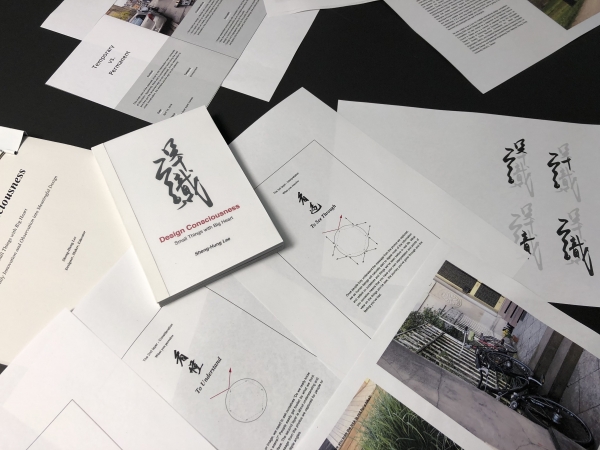
Inspiration from My Three-month Stay for the Designer in Residence Program in Germany - Part 1/4
2019.07.24
I. Jogging Diary: Design Consciousness: Small Things with Big Heart
During the three-month Designer in Residence program, I’ve managed to put together a little book, Design Consciousness: Small Things with Big Heart, recording my life here with photos. I got the idea in my jogging along the riverside park in Pforzheim, a regular 30-minute exercise I’ve been doing at 7 a.m. three times a week. I saw the sport at first as purely my way of workout for keeping healthy, like what I had been doing while living in Shanghai. I would take the wireless headset, sunglasses for sports, and the keys with me while jogging. (* Fig 1 – Prototype for the book Design Consciousness: Small Things with Big Heart (Photo courtesy: Sheng-Hung Lee))
You will not jog in a new city without surprising discoveries. Carrying my iPhone with me all the time, I’ve captured every moment with pictures. Alternate paths for jogging, such as the riverside trail in natural surroundings, city streets across crowded shop stores, university campus and tourist attractions present different spectacles for appreciation. In a word, jogging makes me more observant of and sympathized with the city.
This photo (** Fig 2 - Community public bookshelf that reflects the concept of sharing economy (Photo courtesy: Sheng-Hung Lee)) was taken in the children’s playground in the city square, where an open-ended red bookshelf was frequented by both the elderly and young people in the community. They would stop at the bookshelf and choose the books they feel like borrowing, as well as contribute some of their books to the bookshelf. After asking around, I knew from the local residents that it was a bookshelf for public use. People may take books away from the bookshelf to read back at home and also donate some of theirs. Isn’t this the best example of localization for sharing economy?
Another interesting story I’d like to share is about the trash can (*** Fig 3 – Locked trash can in the street (Photo courtesy: Sheng-Hung Lee)). I remember one day when I was jogging and got intrigued by a trash can along the street. I was asking myself, “why the lock on the trash can?” The trash wouldn’t be worth much on onehand, and putting a lock on the trash may made it more difficult to throw away the trash on the other, which violates the humancentered principle of design. Ten minutes of hard thinking by myself hasn’t solved this puzzle. And it was unraveled only after my colleague told me that trash in Germany is charged by its amount and weight, and people tend to lock their trash cans to prevent others from throwing their trash in them which may cause extra fees.
These lifestyles and cultures reflected therein have offered fresh insights for me as an eastern designer. It is my wish to draw conclusions from the everyday trivial matters people take for granted, and explore possibilities for innovation. In this photo dairy, I’ve put what I saw and heard during the three-month stay in Germany on record with pictures, each of which is analyzed adopting the simple three-part structure: context-consideration-concept. As creative professionals, what is required of us is not only seeing what is there to be seen on the surface. This is just the first level of observation – “To See”, a reflection of the object under the sun. Moving toward the second level – “To Understand”, we should get to know the product and the story behind it, in order to connect the content with the form of the product. The highest level – “To See Through” requires unique perspectives and insightful points of view towards a matter or a product, which is what true understanding is about. Readers that are interested with the book can learn more about it on https://www.smallthingswithbigheart.com/.
……To be continue
---------------------------------------------------------------------------------
About the author - Sheng-Hung Lee (**** Fig 4 – Author Profile)
Designer, Maker, Adjunct Associate Professor at Fudan University Shanghai Institute of Visual Art
Sheng-Hung Lee is a designer, maker and educator. He is inspired by multiple domains of knowledge, different perspectives, and he thrives on creating new value for clients in multi-disciplinary teams. He is trained as an industrial designer and electrical engineer, and his approach to problem solving is influenced by his passion for how design and technology impact on and can be integrated into society. He has recently collaborated with the Industrial Designers Society of America (IDSA) to inform their strategy, service and user experience for the Asia market, and led the effort to incorporate such work in his recent book “IDSA Blueprint in Asia”. Sheng-Hung has been focusing on organization design that creates systemic impact. He was invited to be a jury for multiple international design competition including IDEA, Spark Design Award, IDA Award and A’ Design Award and Competition. He is a member of respected institutions such as Taiwan Society of Technology and Sociology, Phi Tau Phi Scholastic Honor Society, and China Technical Consultants Inc.
Sheng-Hung graduated with a double Bachelor’s degree (Hon.) in Industrial Design and Electrical Engineering from National Cheng Kung University (NCKU), Taiwan. His work has won prestigious awards including IDEA Gold, Braun Prize, Core77 Design Award, Red Dot (Best of the Best), Spark Design Award, European Product Design Award (Gold) and iF Award. His works have also been showcased in Dubai Design Week, Venice Design Week and the Cooper Hewitt museum. Sheng-Hung teaches product design at
Fudan University Shanghai Institute of Visual Art and Detao Masters Academy as adjunct associate professor.

